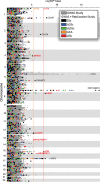Identification of CSK as a systemic sclerosis genetic risk factor through Genome Wide Association Study follow-up
- PMID: 22407130
- PMCID: PMC3368627
- DOI: 10.1093/hmg/dds099
Identification of CSK as a systemic sclerosis genetic risk factor through Genome Wide Association Study follow-up
Abstract
Systemic sclerosis (SSc) is complex autoimmune disease affecting the connective tissue; influenced by genetic and environmental components. Recently, we performed the first successful genome-wide association study (GWAS) of SSc. Here, we perform a large replication study to better dissect the genetic component of SSc. We selected 768 polymorphisms from the previous GWAS and genotyped them in seven replication cohorts from Europe. Overall significance was calculated for replicated significant SNPs by meta-analysis of the replication cohorts and replication-GWAS cohorts (3237 cases and 6097 controls). Six SNPs in regions not previously associated with SSc were selected for validation in another five independent cohorts, up to a total of 5270 SSc patients and 8326 controls. We found evidence for replication and overall genome-wide significance for one novel SSc genetic risk locus: CSK [P-value = 5.04 × 10(-12), odds ratio (OR) = 1.20]. Additionally, we found suggestive association in the loci PSD3 (P-value = 3.18 × 10(-7), OR = 1.36) and NFKB1 (P-value = 1.03 × 10(-6), OR = 1.14). Additionally, we strengthened the evidence for previously confirmed associations. This study significantly increases the number of known putative genetic risk factors for SSc, including the genes CSK, PSD3 and NFKB1, and further confirms six previously described ones.
Figures



References
-
- Gabrielli A., Avvedimento E.V., Krieg T. Scleroderma. N. Engl. J. Med. 2009;360:1989–2003. - PubMed
-
- Agarwal S.K., Tan F.K., Arnett F.C. Genetics and genomic studies in scleroderma (systemic sclerosis) Rheum. Dis. Clin. North Am. 2008;34:17–40. - PubMed
-
- Jimenez S.A., Derk C.T. Following the molecular pathways toward an understanding of the pathogenesis of systemic sclerosis. Ann. Intern. Med. 2004;140:37–50. - PubMed
-
- Romano E., Manetti M., Guiducci S., Ceccarelli C., Allanore Y., Matucci-Cerinic M. The genetics of systemic sclerosis: an update. Clin. Exp. Rheumatol. 2011;29:S75–S86. - PubMed
-
- Martin J., Fonseca C. The genetics of scleroderma. Curr. Rheumatol. Rep. 2011;13:13–20. - PubMed
Publication types
MeSH terms
Substances
Grants and funding
LinkOut - more resources
Full Text Sources
Medical
Miscellaneous

